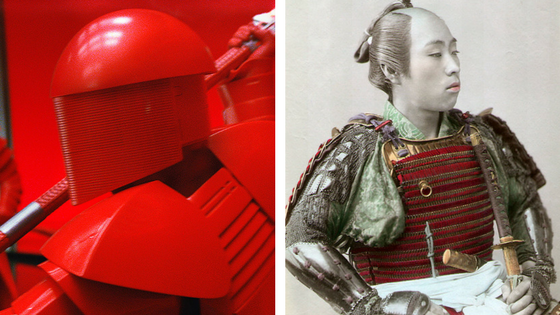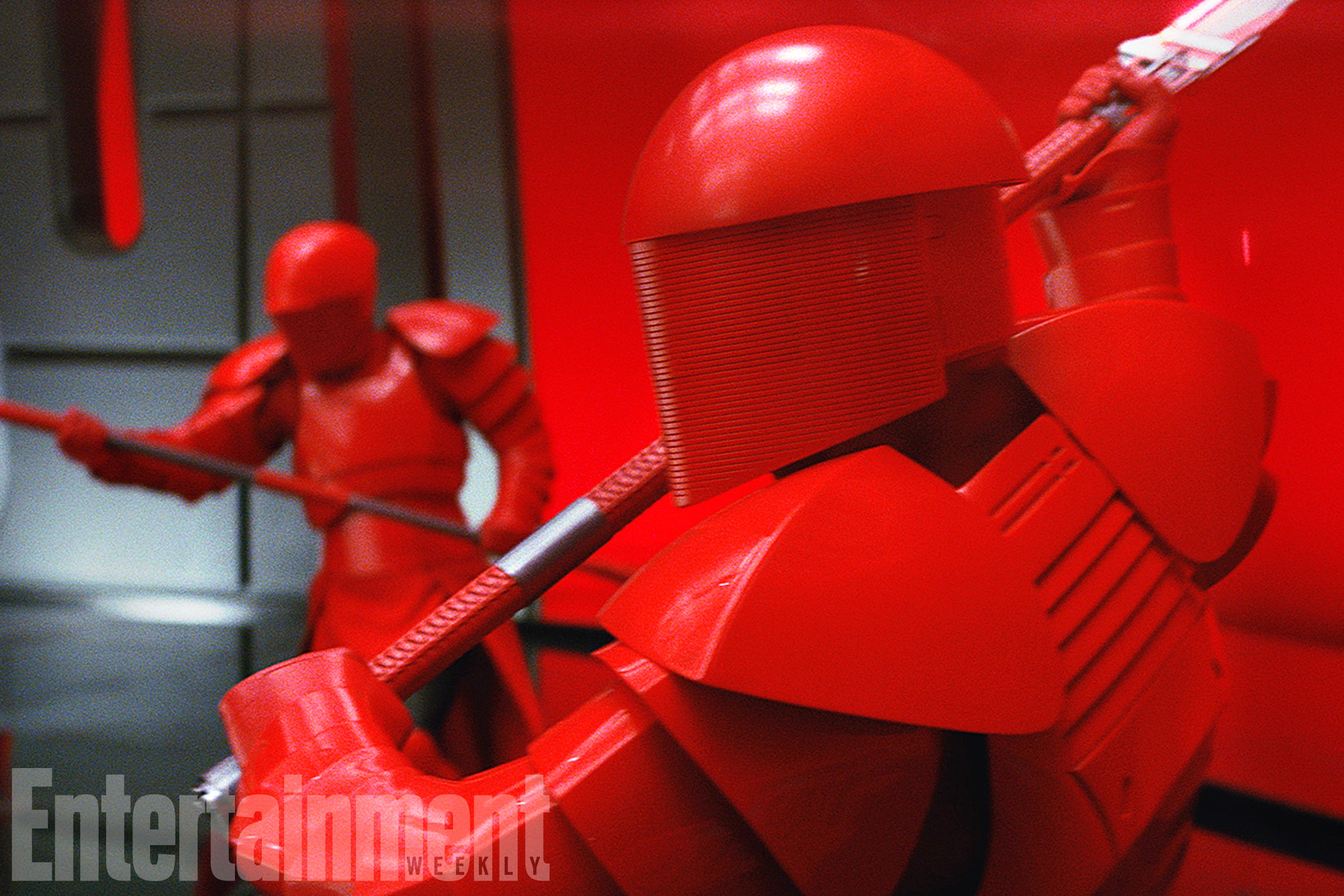If you’re a Star Wars fan, you’ve definitely seen the arresting image of the new enforcers in Star Wars: The Last Jedi, the Praetorian Guard.
In an interview with Entertainment Weekly, writer-director Rian Johnson revealed that the Guard, Supreme Leader Snoke’s personal protectors, is a more amped-up version of the Imperial Guard in The Return of the Jedi.
While the guards get their name from the real life guards who protected ancient Roman emperors, the look and feel of the Praetorian Guard is clearly more samurai in nature. Star Wars fans are already intimately aware of the cyclical nature of the Star Wars lore–any theme that has come up in the past can (and probably will) come up again. The same can be said of the Japanese influence on Star Wars, which is embedded right in the DNA of the Praetorian Guard.
The Jedi, samurai with lightsabers

Johnson gave Entertainment Weekly the background on the Praetorian Guard, including the guard’s Japanese connection.
“The Emperor’s guards were very formal, and you always got the sense that they could fight, but they didn’t. They looked like they were more ceremonial, and you never really saw them in action,” he said. “The Praetorians, my brief to [costume designer] Michael Kaplan was that those guys have to be more like samurai. They have to be built to move, and you have to believe that they could step forward and engage if they have to. They have to seem dangerous.”
The Praetorian Guard are wearing a simplified, almost-blocky style of samurai armor with a touch of the 1980s digital aesthetic in the curved grate that makes up the Praetorian helmet visor. However, the idea of samurai is nothing new to Star Wars. The Jedi themselves are based on the idea of the samurai, including the unwritten code the Jedi live by, a type of space-bushido (without the ritualistic honor-bound suicide, seppuku, of course–these are “kids’ films” after all). Even Darth Vader’s iconic headgear and outfit are based on ornamental samurai armor.
As Samurai: The Last Warrior author John Man wrote for Salon:
…I looked at the inspiration behind the look of both the Jedi Knights and their opponent Darth Vader. So much of it derived from samurai traditions: the cloaks, the tunics, Vader’s helmet, the lightsaber.
…They are expert in the use of swords, despite their ability to call on the most fearsome and destructive of long-distance weapons…Both forgo armor to fight in loose tunics. That is how the Last Samurai, Saigo Takamori, went into battle against the Japanese Empire in 1877; that is how Toshiro Mifune appears in Kurasawa’s film “The Seven Samurai”; that is how young Skywalker, up and coming Jedi, faces up to Vader, the father hehs lost to the Dark Side of the Force.
[With regard to Darth Vader’s armor]: …[A]fter Japanese unification in 1600, the samurai became redundant, but instead of vanishing they reinvented themselves as vital members of society, adopting ever more extreme armor designs, with overlapping plates, masks with bristling mustaches and helmets with horns, or crab-like extensions (symbols of protection), or rabbits’ ears to suggest longevity. Vader’s headgear is a simplified version of a samurai face-mask and helmet, with neck protection and ear-flaps. Unlike a samurai, though, he does not need a hole in the top of his helmet through which to poke an elaborate top knot.
Side-by-side comparisons really show the connective thread between the samurai, the Jedi, and fallen Jedi like Darth Vader and his Imperial Guard.

Even after we move away from the original Star Wars films, the idea of samurai-esque robes remains throughout the Star Wars universe, including the latest in the Star Wars main storyline, The Force Awakens.
Star Wars “samurai-in-space” focus comes from George Lucas himself. As Ollie Barder wrote for Forbes:
It’s widely known that George Lucas was a fan of Akira Kurosawa’s work and famously used inspiration from films like The Hidden Fortress for many of the film’s plot and characters as well as whole scenes.
Barder goes on to write that even the word “Jedi” stems from a Japanese connotation.
…[T]he term “jidaigeki is Japanese for “period drama.” Films like The Hidden Fortress and other aspects of Kurosawa’s oeuvre were often period pieces. Featuring the trials and tribulations of samurai and peasants caught in-between petulant warlords.
The word itself also gave birth to the Jedi and it’s no surprise that they too borrowed many elements from the samurai as well.
Lucas borrowing for the real world is nothing new; Lucas has used the name of Tunisian city Tataouine as the basis for the name of the desert planet Tatooine and in the Star Wars prequels, the costume design for Padme/Queen Amidala feature motifs from several world cultures. In Rogue One, the idea of a space Mecca, Middle Eastern stereotypes and all, is apparent in the spiritual planet Jedha. There are even more examples of Lucas borrowing from other Japanese properties. But despite all of the other disparate elements Lucas brings into his world, including 1950s diners (looking at you, Clone Wars), the biggest throughline in Star Wars is that this is a space opera featuring space samurai protecting the innocent against the space ronin, masterless samurai who are only thirsty for power.
A Shinto color for protection used for evil
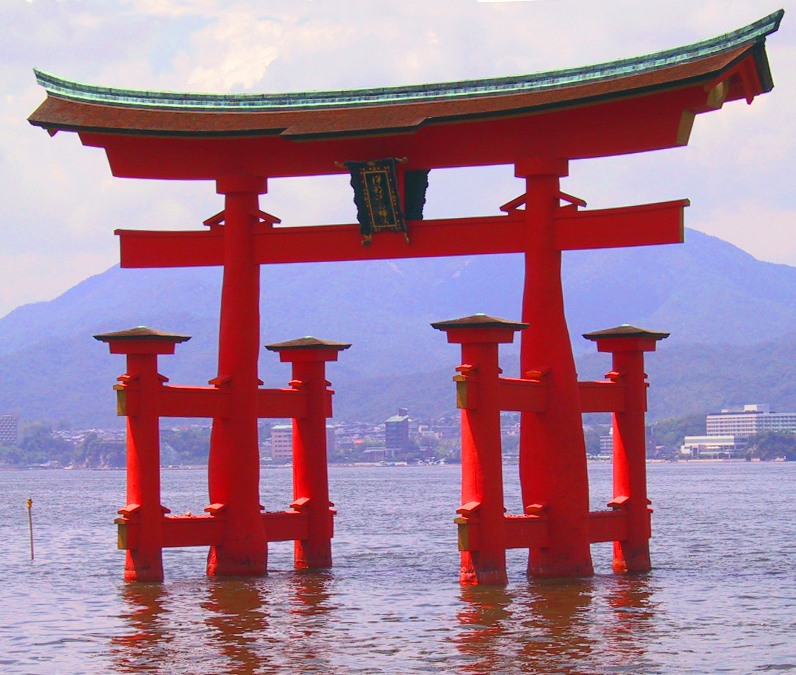
The Praetorian Guard’s relationship with Japan doesn’t end with just Lucas and Johnson’s affinity for samurai. The bright red color that forms the Praetorian Guard’s formidable look also has ties to Japanese culture. In this case, it’s more than just mere borrowing–it’s borrowing with irony.
There are several meanings for the color red in Japan (as is anywhere else), but there is a particular meaning for red in the traditional Shinto religion: protection. However, unlike with the Praetorian Guard, who’s charged with protecting an evil leader, red is charged with protecting Shinto worshippers from evil and disease.
According to Mark Schumacher, who wrote about the history of red in Shinto, the meaning of red might have come from “demon quelling and disease (e.g., smallpox, scarlet fever, tuberculosis, measles).”
According to Japanese folk belief, RED is the color for “expelling demons and illness.” The rituals of spirit quelling were regularly undertaken by the Yamato court during the Asuka Period (522-645 AD). Centered on a fire god (a red deity), these purification rites were designed to purify the land by sending evil spirits to the Ne no Kuni [“The Land of Roots,” an underworld]. This association with evil easily segues into other links with child mortality, protection against evil forces (sickness), fertility, the caul (embryonic membrane covering the head at birth), and other child-birth imagery. The red bibs, red robes, red scarfs, and red caps found frequently on certain Japanese deities…lend strong support to his interpretation.”
Schumacher wrote that for a small amount of time, the Japanese god of smallpox, Hōsō Kami, was closely linked to the color red. This association came at some point between smallpox’s initial introduction to Japan in 550 AD and the first recording of smallpox in 720 AD. It was believed that if the skin of a person afflicted with smallpox turned purple, they would die, but if the skin turned red, they would live. Eventually red came to mean protection against ailments.
This early association between demons of disease and the color red was gradually turned upside down–proper worship of the disease deity would bring life, but improper worship or neglect would result in death. In later centuries, the Japanese recommended that children with smallpox be clothed in red garments and that those caring for the sick also wear red…The Red-Equals-Sickness symbolism quickly gave way to a new dualism between evil and good, between death and life, between hell and heaven, with red embodying both life-creating and life-sustaining powers. As a result, the color red was dedicated not only to deities of sickness and demon quelling, but also to deities of healing, fertility, and childbirth.
An argument could be made that, if the Star Wars crew were conscious of the fact that red has such a huge meaning in Shinto, maybe they were using red to align the Guard and Snoke even more with the evil and danger they represent. However, with what red has come to mean in Shinto over time, the all-red Praetorian Guard is more of an unintentional ironic statement; just like the red torii gates that signify a protection of the spiritual realm and a cleansing of the worshippers that stand near, the Guards are protectors who signify that entering Snoke’s realm is a rarefied experience. However, unlike those that visit torii, there’s no holiness or goodness to come from the Guard and especially not from Snoke. Instead of healing, there’s only spiritual disease.
Aniline Red

The history of red gets even more complicated when you add westernization into the mix. If you notice, the color of the Praetorian Guard is not just red, but it’s a shocking red. It’s a red that makes you sit up and stand at attention. It’s an unnatural red, to be sure.
This unnatural red looks like it could be aniline red, a synthetic color that owes part of its origins to British scientist William Henry Perkin trying to find a cure for malaria. You can read more about aniline red’s road towards becoming a marketable color at Prints of Japan, but just keep in mind that it was the Europeans who brought this synthetic color to Japan. I would say it’s become one of its more iconic colors, too; as a synthetic, it’s able to keep its vibrancy over hundreds of years, compared to Japanese prints that utilize natural red dyes.
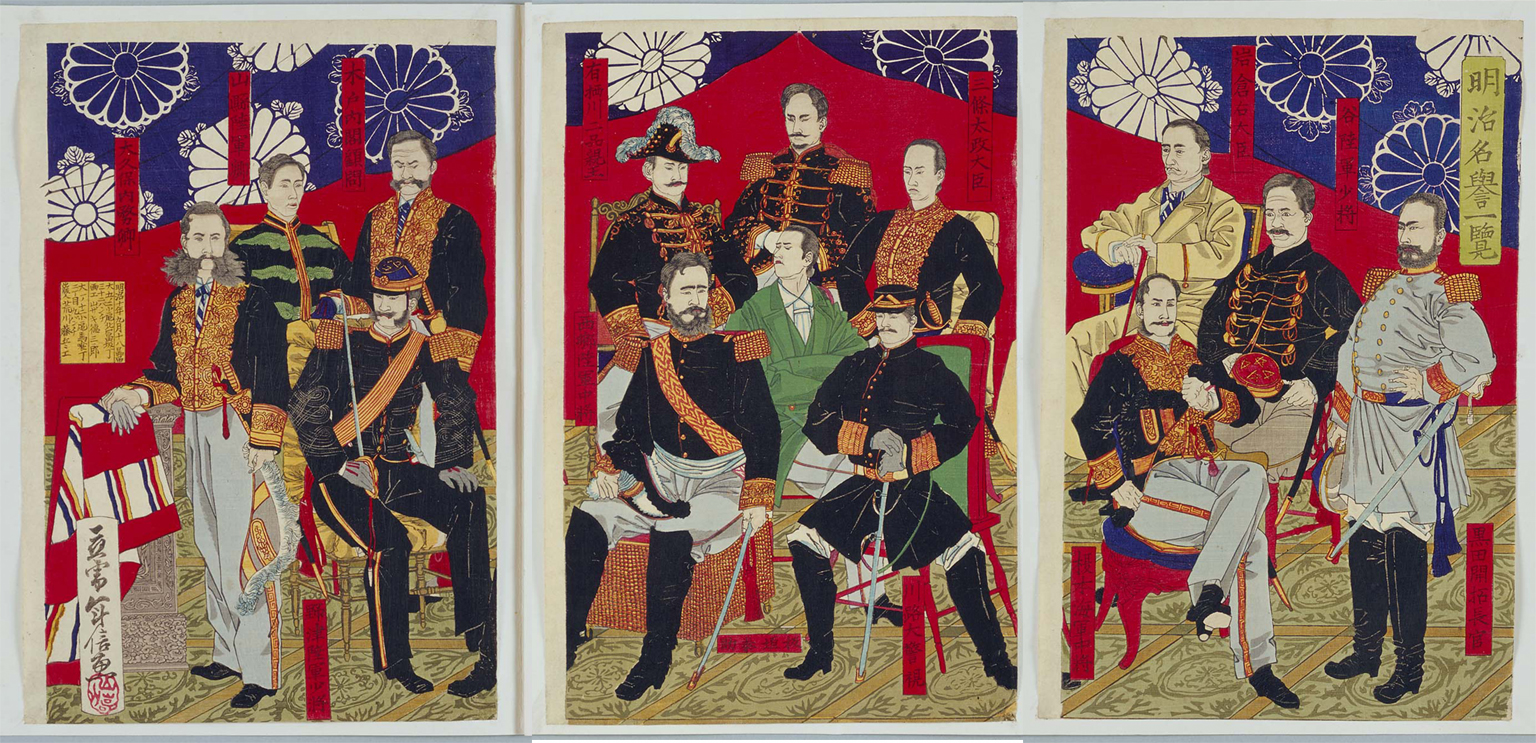
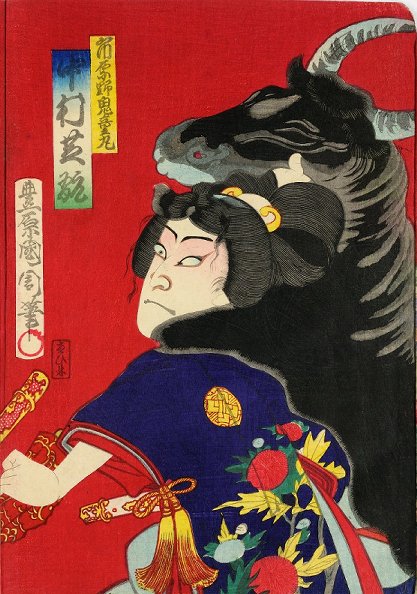
These two prints are saturated in aniline red; see how pop-arty they make these 19th century pieces?
I don’t know if the folks behind Star Wars recognized they were playing deep into the Japanese color history by making the Praetorian Guard shockingly red. Of course, the Imperial Guard are also red, and the real Praetorian Guard were also associated with red. But with so much Japanese influence making its way into the Praetorian Guard, it’s funny that even this small element of Japanese history snuck its way in.
Final thoughts
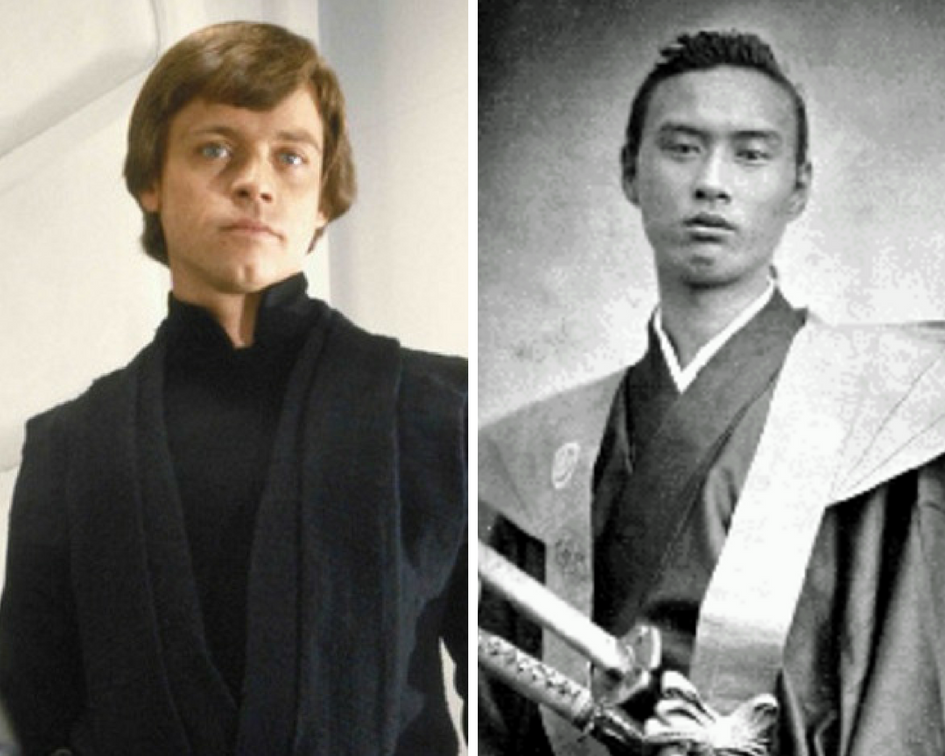
So what does all of this mean in the end? It seems like there’s a conversation to be had about where the line stops when it comes to “appropriation” versus “inspiration.” It’s very easy to say that Lucas was inspired by samurai films he saw growing up, much like how Quentin Tarantino was inspired by the blaxploitation and grindhouse films he saw as a kid. While it’s certainly clear that Lucas found a more elegant way to showcase his inspirations by way of a space opera, is there much difference between Lucas’ insistence on direct Japanese ties to his work and Tarantino’s insistence on directly imitating and reworking major themes from blaxploitation? To a certain degree, both Lucas and Tarantino straddle the line between appreciation and flat-out lifting (or, to be nicer about it, “paying homage.”)
If you’re being really nitpicky, you could say that many directors out there steal from their favorite films. No doubt–every director has put in a scene that mimics a scene they’ve loved from their childhood films. But where it gets interesting for Lucas and Tarantino is that there’s a certain amount of damage attributed to how they represent (or don’t represent) the cultures they’re drawing from.
For instance, how can Lucas draw inspiration from Japanese films just to give a set of bumbling aliens stereotypical Asian accents in the Star Wars prequels? How can it be that Lucas has only rarely featured Asian faces in general–much less specifically Japanese faces–on screen? The Force Awakens, the upcoming Last Jedi and Rogue One have featured more Asian characters than the prequels and the originals combined, and all three of those movies have been under the inclusionary focus of J.J. Abrams, not Lucas. This article isn’t about Tarantino, but since I’ve brought him up (and since I’m black) it’s time to start talking about how Tarantino only views blackness through a limited scope, not through how actual black people behave. (Yeah, I know he marched against police brutality, but that’s the least he could do–that’s something we all should be doing, to be honest.)
With all of this said, where does this put the Praetorian Guard? It would seem, regardless of the arguments made for or against “paying homage,” the mysterious samurai and Japan’s relationships with spirituality and color are imports to Western culture that still fascinate us and keep us fascinated with the culture of the Land of the Rising Sun. The Guard are only one more block that cements that fascination.
